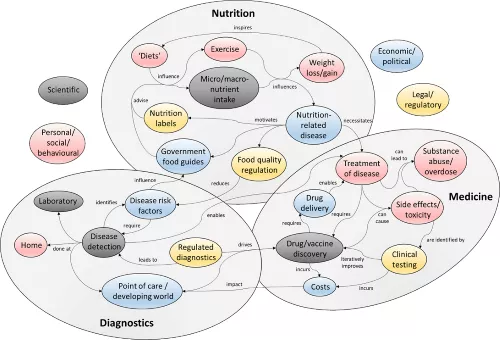
David Armstrong
-
E-mail:
-
Phone:
-
Mailing Address:
3359 Mississauga Road
Mississauga ON L5L 1C6
Canada
Research Areas:
Active Learning, Systems Thinking, Computational Chemistry, Organometallic Chemistry
Research Profile:

My current work focuses on incorporating systems thinking into undergraduate chemistry education. Systems thinking reaches beyond isolated contexts and chemical systems to provide a more holistic view of the field and its interrelations with personal, societal, and environmental systems. This has been demonstrated in CHM101H, in which chemical concepts are taught within the system of human health, using the subsystems of nutrition for the prevention of disease, diagnostics for the detection of disease, and medicine for the treatment of disease. This approach encourages students to build an appreciation for the role that chemistry plays in society, helping them to transfer their knowledge beyond the course in which it was learned. Moving forward, my goal is to investigate the potential benefits of a similar systems thinking approach for the instruction of CHM110H and CHM120H.
Computational chemistry methods are widely used in all fields of chemical research and are rapidly becoming a common element of the chemist’s toolkit. Computational chemistry is used to support experimental observations and to investigate the structure and properties of chemical systems. These properties include equilibrium geometries, energies, charge distributions, dipoles, vibrations, reactivity, and spectroscopic properties. Introducing computational methods and the associated software packages at the undergraduate level carries many benefits, including:
- developing the ability to translate between 2D and 3D chemical structures,
- improving visualization of chemical systems,
- relating predicted properties to experimental results, and
- building transferrable skills for chemistry research.
I am currently working toward incorporating computational chemistry into the undergraduate curriculum from first year, through to the senior undergraduate level.
Courses Taught:
CHM110H5, CHM120H5, CHM101H5 (undergraduate)
Publications
Armstrong, H. K.; Bording-Jorgensen, M.; Santer, D. M.; Zhang, Z.; Valcheva, R.; Rieger, A. M.; Kim, J. S-H.; Dijk, S. I.; Mahmood, R.; Ogungbola, O.; Jovel, J.; Moreau, F.; Gorman, H.; Dickner, R.; Jerasi, J.; Mander, I. K.; Lafleur, D.; Cheng, C.; Petrova, A.; Jeanson, T-L.; Mason, A.; Sergi, C. M.; Levine, A.; Chadee, C.; Armstrong, D.; Rauscher, S.; Bernstein, C. N.; Carroll, M. W.; Huynh, H. Q.; Walter, J.; Madsen, K. L.; Dieleman, L. A.; Wine, E. Unfermented β-fructan Fibers Fuel Inflammation in Select Inflammatory Bowel Disease Patients. Gastroenterology 2023, 164(2), 228-240.
Armstrong, H.; Mander, I.; Zhang, Z., Armstrong, D., Wine, E. Not All Fibers Are Born Equal; Variable Response to Dietary Fiber Subtypes in IBD. Front Pediatrics. 2021, 8, doi: 10.3389/fped.2020.620189.
Armstrong, D., Murck, B.; Poë, J. C. Service Learning Opportunity for Undergraduate Science Students: Integrating Problem-Based Learning in the High School Science Curriculum. J. Chem. Educ. 2020, 98 (4), 1275-1282.
Armstrong, D.; Poë, J. The Science of Human Health – A Context-Based Chemistry Course for Non-Science Majors Incorporating Systems Thinking. J. Chem. Educ. 2020, 97 (11), 3957-3965.
Hassan, M. M.; Israelian, J.; Nawar, N.; Ganda, G.; Manaswiyoungkul, P.; Raouf, Y.; Armstrong, D., Sedighi, A.; Olaoye, O. O.; Erdogan, F.; Cabral, A. D.; Angeles, F.; Altintas, R.; de Araujo, E. D.; Gunning, P. T. Characterization of Conformationally Constrained Benzanilide Scaffolds for Potent and Selective HDAC8 Targeting. J. Med. Chem. 2020, 63 (15), 8634-8648.
Mirabi, B.; Poh, W. C.; Armstrong, D.; Lough, A. J.; Fekl, U. Why Diorganyl Zinc Lewis Acidity Dramatically Increases with Narrowing C-Zn-C Bond Angle. Inorg. Chem. 2020, 5, 2621-2625.
Taullaj, F.; Armstrong, D.; Datta, S.; Lough, A. J.; Fekl, U. 2-Adamantyl Complexes of Platinum. Eur. J. Inorganic Chem. 2019, 9, 1288-1291.
Kraskouskaya, D; Cabral, A. D.; Fong, R.; Bancerz, M.; Toutah, K.; Rosa, D.; Gardiner, J. E.; de Araujo, E. D.; Duodu, E.; Armstrong, D.; Fekl, U.; Gunning, P. T. Characterization and Application Studies of ProxyPhos, a Chemosensor for the Detection of Proximally Phosphorylated Peptides and Proteins in Aqueous Solutions. RSC Analyst 2017, 142, 2451.
Armstrong, D.; Taullaj, F.; Singh, K.; Mirabi, B.; Lough, A. J.; Fekl, U. Adamantyl Metal Complexes: New Routes to Adamantyl Anions and New Transmetallations. Dalton Trans. 2017, 46, 6212.
Armstrong, D.; Daryanavard, M.; Lough, A. J.; Fekl, U. The First Palladium(IV) Aryldiazenido Complex: Relevance for C-C Coupling. Dalton Trans. 2017, 46, 4004.
Taullaj, F.; Armstrong, D.; Lough, A. J.; Fekl, U. Iridium Complexes Containing N- Donor-functionalized η1-Fluorenyl Ligands. Polyhedron 2016, 108, 30.
Daryanavard, M.; Armstrong, D.; Lough, A. J.; Fekl, U. Extremely Facile Transformations of Tris(3,5-dimethylpyrazolyl)borate: a Bidentate Nitrogen Ligand and a C2-Chiral Cation. Eur. J. Inorganic Chem. 2015, 20, 3232.
